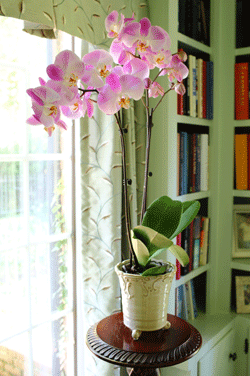 To thrive, Phalaenopsis orchids require the correct amount of water (see our previous post), adequate light, and proper temperature. Of these three basic elements of orchid care, Phalaenopsis owners have the most trouble judging light. After over-watering, insufficient light is the most-likely culprit when orchids do poorly.
To thrive, Phalaenopsis orchids require the correct amount of water (see our previous post), adequate light, and proper temperature. Of these three basic elements of orchid care, Phalaenopsis owners have the most trouble judging light. After over-watering, insufficient light is the most-likely culprit when orchids do poorly.
Part of the problem is that humans and plants perceive light differently. When we judge the amount of light in a room, we tend to generalize as if the quality of light were identical in every corner of the room. An orchid, on the other hand, is only concerned only with the precise amount of light that reaches the particular portion of the table in the specific corner of the room where you have plopped it down. Because the strength of sunlight diminishes quickly the farther away from the window you move, a plant placed in the middle of a bright room may only be getting a fraction of the light you think it’s getting. For example, just one foot away from a sunny window, light values can drop by as much as 50%.
Unfortunately, we can’t always place our orchids where they will receive optimal light. Our homes do not always have windows where we want them which can limit our options when seeking a good place to display our orchids. Fortunately, Phalaenopsis orchids have fairly low light requirements compared to other orchid species. Exposure to direct sunlight can actually burn and damage the leaves of Phalaenopsis orchids. Phals thrive in indirect light and do equally well in sunlight or artificial light which makes them a good choice for interior rooms and office settings.
Watch our orchid care video for additional information on proper lighting for your Phalaenopsis orchid.
Next time: Temperature

Copyright Just Add Ice® Orchids 2023